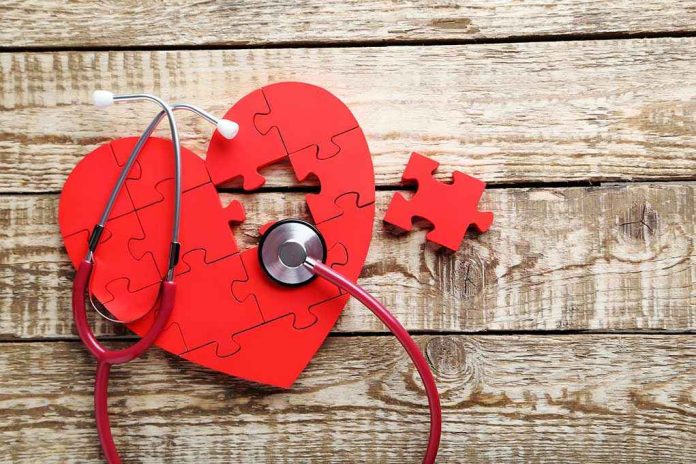
Nearly half of American adults now face a future where blood pressure medications come sooner, sodium drops lower, and risk assessment gets sharper—all under sweeping new 2025 guidelines that promise to change how we fight heart disease, stroke, and dementia.
Story Snapshot
- Earlier blood pressure drug therapy now recommended after just 3–6 months of lifestyle changes.
- New PREVENT risk calculator personalizes cardiovascular and kidney risk prediction.
- Sodium intake goal drops dramatically to 1500 mg/day for most adults.
- Expanded prevention focus now includes special populations and dementia risk.
America’s Blood Pressure Battle Gets a New Playbook
August 2025 marks a turning point for hypertension care in the U.S. The American Heart Association and American College of Cardiology, backed by eleven other medical societies, have released new clinical guidelines that disrupt decades of tradition. For the first time, physicians are urged to start drug therapy for high blood pressure within three to six months when lifestyle tweaks don’t cut it. This move ends years of debate about whether to wait and watch or act fast, targeting the stubbornly high rates of stroke, heart attack, and kidney failure that plague nearly half of American adults.
The guidelines maintain the well-known target of keeping blood pressure below 130/80 mm Hg. What’s new is the sense of urgency. If diet, exercise, and stress reduction have not tamed blood pressure after a few months, a prescription pad comes out. This approach aims to prevent the silent damage that accumulates in arteries, kidneys, and even the brain years before symptoms appear. The shift toward earlier intervention reflects powerful new studies reviewed since 2015, showing that waiting too long costs lives and health.
Personalized Risk, Not One-Size-Fits-All
For patients and doctors alike, the launch of the PREVENT risk calculator is a game-changer. Rather than relying on generic risk charts, clinicians can now enter individual patient data—age, race, kidney function, diabetes status—and get an integrated assessment of future cardiovascular, kidney, and metabolic risks. This tool helps decide who needs drugs quickly and who may benefit from intensified lifestyle changes or combination therapy. The calculator also brings clarity to difficult cases, like resistant hypertension or complex medical histories, making modern medicine less about guesswork and more about precision.
Expanded guidance now covers groups long underserved by previous guidelines. Patients with chronic kidney disease, diabetes, and pregnant women get tailored recommendations. The guidelines also push for greater screening for secondary causes of hypertension, like primary aldosteronism, and emphasize the need to address psychosocial factors—stress, depression, and social isolation—that can sabotage blood pressure control. For older adults, the focus widens to dementia prevention, recognizing the link between unchecked hypertension and cognitive decline.
Sodium: The New Low
For decades, Americans have wrestled with salt. The new guidelines cut the recommended daily sodium intake to 1500 mg, down from previous targets. This may sound technical, but it means the average person needs to slash their salt consumption by nearly half. The evidence is clear: lower sodium equals lower blood pressure, and that means fewer strokes and heart attacks. Critics argue that such a drastic cut may be tough to achieve, especially in communities where processed and restaurant foods reign. But the guidelines call for aggressive public health measures—food industry reformulation, consumer education, and policy change—to make low sodium the new normal.
Alongside sodium, the guidelines renew their emphasis on lifestyle: weight loss, regular exercise, moderating alcohol, and quitting tobacco. But for those who can’t reach blood pressure goals with lifestyle alone, the message is clear—medications should not wait. Single-pill combinations are favored for better adherence, and home blood pressure monitoring is strongly encouraged. The new recommendations recognize that controlling hypertension is not just a medical challenge, but a behavioral, social, and economic one.
More Than Just Numbers: The Ripple Effect
Short-term, the new guidelines mean more Americans will start antihypertensive medications earlier, with closer follow-up and personalized risk assessment. Health systems must ramp up patient education, invest in home monitoring technology, and coordinate care across primary and specialty providers. The pharmaceutical industry will see increased demand for combination drugs and new therapies, while device makers may benefit from expanded use of renal denervation technology. Public health initiatives, meanwhile, will need to push harder on sodium reduction and lifestyle programs.
Long-term, the hope is for measurable drops in cardiovascular events, kidney disease, and dementia. By catching and treating high blood pressure earlier, and by tailoring interventions to individual risk, the guidelines aim to reduce health disparities and improve outcomes for high-risk groups. As always, the devil is in the details—implementation will require resources, training, and buy-in from clinicians and patients alike. Some experts still debate whether the sodium goals are realistic or if earlier drug therapy risks overtreatment, but consensus supports the overall direction: act sooner, personalize care, and prevent more disease.
Sources:
AHA Professional Heart Daily, 2025-08-14
AHA Hypertension Scientific Sessions, 2025-06-09





